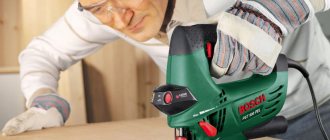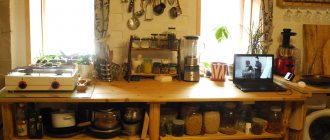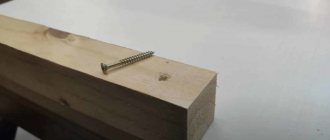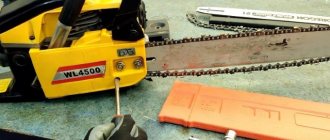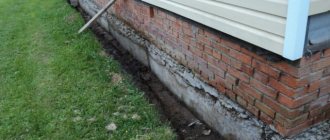A good master never has too many clamps. Why? Yes, because specific types of work require specific clamping devices. In addition, they differ in size: in some places you need a small clamp, in others you need a larger one.
I know one master who has more than a hundred different clamps stored in his workshop: small, medium and large. Despite this, he constantly complains that he doesn’t have enough of them... Well, it’s understandable - the more different operations you have to perform, the more clamps you will need.
If you suddenly urgently need some kind of clamp that you don’t have, don’t rush to go to the store: you’ll only waste time and money.
It is much easier to make a clamp with your own hands, using materials (new or used) that are available. Many home craftsmen do this. I recommend that you do the same.
Why is this beneficial? Firstly, you will reduce the “deposits” of scrap metal. Secondly, you can make a clamp of the required shape and size (you may not find the required clamp in stores).
As for materials, to make homemade clamps you can use profile pipes, sheet metal, corners, car and bicycle spare parts.
As a rule, metal is used to make metalwork clamps - they must be reliable and durable, and withstand heavy loads.
Whereas carpentry clamps are usually made from hardwood (oak, walnut, acacia, hornbeam) or plywood.
But if necessary, they can also be made of metal - for example, corner clamps designed for gluing workpieces at an angle of 90 degrees are usually made of metal so that they can also be used when performing metalwork operations.
Homemade clamping devices differ not only in their actual purpose (for example, they are used specifically for plumbing or only for carpentry work) and the materials from which they are made, but also in their scope - in production, during construction or at home.
For example, F-shaped and G-shaped clamps are considered universal - they allow you to work with parts made of different materials and different shapes, fasten workpieces together or fix them to the table. That is, these are both metalwork and carpentry clamps.
In addition to this, there are also other modifications that you can make yourself from metal: for example, corner clamps for welding (they are used to connect and rigidly fix workpieces at a certain angle - usually at 90 or 45 degrees) or pipe clamps - designed to work with large blanks (for example, you can use them for gluing wooden panels).
Do you need to make drawings? This is everyone’s business, but we recommend doing them anyway, since it is very difficult to keep in mind the sizes of the parts used. You may also need them if you want to share your project (how to make a DIY clamp) with other people.
Homemade clamps also differ in design features - for example, most often in workshops they use classic clamps with a screw clamp. But you can also find quick-release clamps, which are convenient to use when performing a large amount of work.
Corner option
Regardless of the type of clamp, it must firmly clamp the parts for joining or processing. A corner joiner helps to fasten wood pieces at a certain angle (most often 90°, but there are others). You cannot do without this when assembling furniture and frames.
In order to make such a clamp from wood with your own hands, you will need the following materials:
- two wooden blocks 25 mm thick made of hardwood;
- plywood 12 mm thick or more;
- screws, studs;
- jigsaw or hacksaw;
- drill.
A square board with a side of 25 or 30 cm is cut out of plywood. Two bars are fixed on it at an angle of 90 °.
Important! The angle must be measured with high precision, since the correct fixation of parts depends on it.
First, the bars are glued, then countersunk, holes are drilled and screws or other fasteners are tightened. Perpendiculars are drawn from the center of the bars - screw studs will pass here.
At a distance of 20 mm from the corners, thrust bars are attached, maintaining a gap between them. It should be slightly larger than the width of the parts that are to be clamped with a homemade clamp. It is better to screw in the studs immediately, before fixing the stops. You will also need to cut out the movable blocks that will be connected to the pin (when it is unscrewed, the workpiece will be pressed against the corner bar).
In the same way, a clamp is made from plywood or chipboard sheets. In it, instead of wooden blocks, a thick plywood sheet is taken. There are other options for making clamps yourself, but the principle of their assembly is generally similar.
Balance check
A rocking chair made of wood may be uncomfortable when sitting down or standing up. This occurs as a result of the difference in the weight of the structural elements that are located in its front and rear parts. To avoid discomfort, it is necessary to balance the swinging structure.
If the structure is significantly tilted forward, transverse strips can be mounted on the runners behind the backrest. If necessary, the weight on the slats can be increased by installing decorative elements.
Balanced Rocking Chair
When tilting backwards, the same counterweight must be equipped in the front part of the rocking chair. This could be an additional shelf for legs. If this weight is not enough, then you can install a niche under the shelf for additional counterweight.
Clamp in the form of a caliper
Devices that are shaped like calipers are used to firmly hold small parts. For a homemade clamp, you will need, as before, plywood and small thickness bars.
For screws, it is best to take studs with rectangular or trapezoidal threads. The thread pitch is 2 turns per cm. It is very good if the stud has a rear sight on one side of a slightly smaller diameter than the thread. It can be used to seat the handle. On the other hand, a rear sight with a slightly larger diameter to accommodate the bearing is desirable.
So, in the simplest clamp, one end will be stationary, and the second will move through a worm gear.
To release the workpiece, you need to move the bracket to the required distance and turn the knob a few turns. This will fix the element. After this, you can release the mechanism and the workpiece will be released.
The simplest version of this model is equipped with a rail structure. The guides, which are arranged in parallel, have cut grooves at equal distances. Fixed stops are secured using rods made of metal. They can move exactly along the width of the workpieces. At the end of the beams, fixed stops should be installed, which have a worm mechanism. The usual method is to clamp it with a hairpin and a furniture nut.
Workflow algorithm
Basically, the clamp clamps parts at right angles. But you can install a slope in the design if necessary.
Metal devices
Metal devices hold the workpiece tightly, they are stable and more reliable.
The following procedure must be followed:
The body part is created, and alloys with a thickness of 10 mm are used to produce the base. Clamps are made from angles that are welded or bolted. A metal rod, console, or several nuts fastened together are suitable for the clamping device. Holes are drilled on the bracket, threads are screwed
Fixed to the base with bolts. When forming an angle, pay attention to the clamping brackets. Connect only corners of the same size
A reliable design would be a fixed coupling with an angle, installation of 2 of the same element, pressed to the brackets and fastened by welding. Correct installation of the mobile device. The guides are attached to the sides; the internal base will move along them. A groove is cut in the direction of the beam dividing the structure from the corner into 2 equal parts. Use a drill to make holes, and use a screwdriver to tighten the bolts with nuts and washers. The hardware is chosen with a thread on the rod, which is not screwed to the head.
You can try these recommendations in practice:
- cut 3 strips of 45 mm wide and 110, 260 and 510 (mm) long from a metal sheet;
- prepare rectangular iron plates;
- weld 1 sheet onto the base;
- 2 steel sheet is welded to the smaller side;
- connected by welding the washer;
- apply the nuts to the moving part.
- the leg of the rod is installed in a parallel position;
- welding of the first steel rectangle is performed to the outside;
- the mobile part is fixed inside the device at the ends;
- The washers are welded to the rod.
The conventional device creates problems with some types of work. Due to the limited installation location that can perform operations at right angles. The limitation is eliminated by a detachable bolted connection and an adjustable clamping bolt. Using hardware, select an angle, then attach the workpieces.
Self-clamping option
For gluing parts, it is better to choose the simplest clamp model, which has an F-shape. The stores sell various models that consist not only of wood, but also of metal. The cost of such instruments is high. Therefore, many craftsmen prefer to make them with their own hands.
For small jobs, a cam-type clamp is ideal. For example, if you need to glue small parts or fix workpieces. This model works in the same way as the f-shaped element. The tool includes 2 jaws and guide bars. Sponges: movable and fixed. For reliable clamping, it is necessary to fix the workpiece well and rotate the cam 90 degrees.
You can make such a tool yourself with a minimum set of tools and materials. Before you begin, you should draw a drawing of the product. You can use any material for manufacturing, and also change the standard sizes as you wish.
The tire is made of wood or metal. Small bolts and rivets can be used instead of metal pins. It is recommended to make movable and fixed jaws at the same time, since they mirror each other. Their width and length can be changed to increase the grip of the product.
Crimping grip
Band crimp clamps (crimp clamps, O-clamps) are rarely used by home craftsmen. But it’s not a technological circumstance that makes me remember them: 3,000 rubles. For a branded one it's still cheap. Meanwhile, an O-clamp that is no worse can be made with your own hands.
For this you will first need a flat textile sling and 4 swivels for it. The corner clamp, jaw and screw clamp slide are made of wood and fiberboard, on the left in Fig. The procedure for use has some peculiarities (by the way, the same applies to the most expensive branded ones).
Homemade crimping clamp for furniture and carpentry work
Let's say we need to assemble a series of identical photo frames. If they are different, the tool will have to be retooled for each. If not, then:
- The product parts are initially assembled dry, without glue.
- Lay it out on a plaz (flat plane) and use the marks on it to set 90 degree angles.
- Loop the slings and place the clamps in the corners.
- By moving the swivels, we achieve a weak, uniform tension on the branches of the sling (on the right in the figure).
- Gradually tighten the clamp, watching the corners of the product.
- If one of the corners diverges, then you need to apply a little sling in its direction, pulling it through the sotv. swivels.
- The adjustment of the crimping clamp is considered complete if it is possible to use a clamp to bring all the corner gaps “into a thread” - there is no need to turn the screw any more.
Now, if a series of products is being made, after gluing one screw, the screw is loosened, the next one is inserted (with glue in the corners), the clamp is tightened “to the threads,” etc.
Materials and assembly steps
In order to make tree clamps, you will need the following elements:
- beech or birch block;
- feather drill;
- pipe 2.5 cm;
- mortise nuts of suitable diameter;
- a nut that has a rounded knob (used for decoration);
- a cutter with a diameter of 2.5 cm and a long pin.
The basis of the material is a pipe, from which a piece of the required length is cut. Depending on the size of the jaws, it is necessary to cut the block. The pieces should be from 15 to 20 cm. For free movement of the timber along the pipe, a hole with a diameter of 2.5 cm should be made at a distance of 2.5 cm from the edge. Parallel to the hole, a cut should be made from the same end. To fix the sponge on the pipe, connect the hole to the end.
For the driving nut, you need to drill an additional hole on the side of the cut. You need to drive a nut into it and tighten it with a bolt on the back side. To fix the sponge, clamp the pipe in the hole. To move the pipe, you need to unscrew the bolt, then move the element and repeat all the steps again.
The lower clamping part has 2 jaws; it is slightly larger than the upper one and has an additional nut. The structure of both parts is identical. An additional driving nut is located at the opposite end of the pipe into which a stud with a wing nut is installed.
In the second collapsible moving part there are no clamping parts such as cuts and nuts. The dimensions of such an element are also rather large. In this part it is necessary to make a recess for the stud device.
Operating principle
The principle of operation of the clamp is very simple. It is necessary to separate the jaws so that they are separated from each other at a distance of 3 cm greater than the width of the shield that will be installed. Next you need to fix them on the pipe. To do this, tighten the nuts that are located at the edges. The blanks must be placed on the tubes and sealed with glue. Then they need to be pulled together by rotating the “lamb”.
If you know how to use a grinder and a welding machine, you can make the same clamp for gluing wood from metal.
To maintain the plane of the plot with tubes, it is recommended to arrange the clamps in a checkerboard pattern. The main advantage of such a tool is its ease of manufacture and operation.
Simple models
A self-made metal clamp, simple in design, will allow you to glue the parts together. You can clamp them and leave them until the glue completely hardens. To do this you need to prepare:
- 2 thick metal strips;
- in each plate there are bright holes that completely coincide with each other;
- Threads are cut on the studs.
Working with the clamping device:
- parts lubricated with adhesive are inserted between the iron sheets;
- use a wrench to tighten the nut on the stud;
- remove for a while until the elements stick together.
Monolithic hacksaw
The next model requires a monolithic hacksaw.
Or rather, you will need saw frames for cutting metal fragments. In addition, prepare:
- hairpins;
- steel plates;
- screws with nuts.
A support platform is welded to one end of the frame, and a nut is installed on the other to install an adjusting screw with a coupling and a handle.
Special clamp designs
Having mastered the skills of making simple-shaped clamps, you can improve them and make devices for connecting complex parts.
There are homemade clamps made from a wooden hanger, which is sawn into pieces. They combine wood and steel and make more comfortable handles that allow you to quickly tighten the screw. This is especially important if you need to frequently change position or use several clamps at the same time. In the case of complex pieces, you can first cut them out of paper and then transfer them to plywood.
Although welded metal products are more reliable, wooden structures are also used not only for carpentry, but also for turning and carpentry. You don't need to have any special skills to create a clamp. You can make such a wooden product in unlimited quantities with your own hands. You just need to devote some time to the manufacturing process.
Source: drevogid.com
Why are glued wood panels made?
Even if the thickness makes it possible to create products with a large width, their subsequent operation raises serious doubts. Those who often deal with wood know very well that solid wood products are quite capricious in terms of use.
To ensure that a wooden product does not lose its original shape, the wood itself must be dried very well in advance. It is advisable to keep the material for at least four weeks in the conditions of the room where the product will be located subsequently. However, this condition is very difficult to comply with when it comes to a window sill or door. Changes in temperature and humidity, one way or another, will lead to deformation.
Gluing helps get rid of this drawback. To do this, wooden blocks are folded into a complete panel and then glued. In order for the workpiece to truly turn into a single whole, a special mechanism is used - a clamp. It can be created quite simply at home, saving a lot on factory models.
Do-it-yourself clamps and clamps
#1 Zhuravlev Nikolay
Good afternoon, welders. I want to share with you what I did. He made clamps and clamps for the manufacture of furniture panels, windows and doors.
Clamp for door ties 2.5 meters 2 pcs.; 3 pieces for fastening windows, doors and furniture panels 1.5 meters; Wire for furniture board 1.0 meter 5 pcs.
Left clamp assembly for door ties 2.5 meters
Right clamp assembly for door ties 2.5 meters
Left lashing unit for tying windows, doors and furniture panels
Right lashing unit for tying windows, doors and furniture panels
#2 Zhuravlev Nikolay
Popular message!
Weight, for gluing furniture panels, compressing it in 4 directions.
Clamp assembly for door ties 2.5 meters
Post edited by Nikolay Zhuravlev: December 25, 2015 22:37
#3 Kurt1
Zhuravlev Nikolay, Do you have a photo of how they work on the product?
#4 Zhuravlev Nikolay
Do you have photos of how they work on the product?
No photos, just finished it recently. As soon as possible. But there is a photo of how they depict the product itself in the “Herringbone” welding competition. cook!”
Post edited by Nikolay Zhuravlev: December 26, 2015 20:19
#5 Barkhudarov
#6 Zhuravlev Nikolay
Andrey in the first photo there are 5 1.0 meter weims, 3 1.5 meter weims and 2 clamps (weims). In carpentry circles there are no clear definitions of these devices; they perform the same function. Many clamps are called clamps and vice versa. That’s why the topic is named so, so that people who want to make them with their own hands can find a solution by searching in search engines for both “vayma” and “clamp.”
#7 Lohus
What caused the choice of such a complex unit design?
It would be easier to take a corner lying on the pipe, even lengthen (make wider) the shelf that lies on the pipe and secure it with 2 bolts from above. Grab the nut from the side of the compressed part, and the seams will not work to separate. Less welding. The strength is sufficient, it is more likely to bend the pipe than the corner.
#8 Zhuravlev Nikolay
What caused the choice of such a complex unit design?
It's simple. This unit is universal. It works as a stop, as well as in tandem with a screw and a heel (if removed from another clamp). Versatility is included just in case. For example, if something happens to the thread on the main unit: it breaks or stretches. Secondly, we don’t always use things for their intended purpose; for example, we can use them in auto repair to straighten the geometry of the body (I don’t know what this tool is called), but you never know what it’s useful for. Therefore, maximum bending strength is provided. The corner, as far as I understand, having scoured the Internet, bends with a bang. Thirdly, there was a small remaining sheet of iron available, which I wanted to use to the maximum without any residue. Somehow this is how the idea of creating such a node came about.
Tell me, Lohus, where does welding work?
#9 Lohus
When squeezing the part, your long nut is pulled out (moved from the assembly); on the other hand, it is enough to grab it, because it will press against the knot.
Versatility - now it’s clear, you can’t weld a nut on the other side.
Post edited by Lohus: December 28, 2015 17:00
#10 Zhuravlev Nikolay
When squeezing the part, your long nut is pulled out (moved out of the assembly
That is, it turns out, in my design, as many as four seams go to the breaking point: 2 - the nut is welded to the bottom plate, 2 - where the bottom plate is welded to the sidewalls.
#11 gonta
Not to pull away, but rather to shift. And these are completely different efforts.
Source: websvarka.ru
Varieties
The purpose of this publication is not to build something like an encyclopedia of mounting clamps - there are many types of them, and there are even more patents for new, “super-super” ones. Our task is to show which clamps are most needed in a home workshop, and how best to make a clamp without wasting a lot of material and time.
The most common types of clamps in handicraft production are shown in Fig:
- G-shaped (G-cramp; G-clamp) - the simplest, most reliable and cheapest of general-purpose clamps. Disadvantages: it takes a long time to tighten and can turn the parts being glued if the stop hinge is of poor quality or not maintained. The latter is quite important: an adhesive layer that has not set is a good lubricant, but it is undesirable to separate and recompress the surfaces being glued together, as the strength of the dried joint decreases sharply. In addition, a regular G-clamp does not hold round parts well, so a special pipe clamp is used to secure pipes or a round profile for welding or butt soldering (see next figure). Assembled from ordinary structural steel s=(2.5-4) mm, such a welded clamp provides reliable fixation of pipes up to d(120-150)x(1.5-4) mm.
- F-shaped (F-cramp). Quick-clamping, operates on the principle of jamming the sliding stop in the dead center position. Pressure until it is firmly secured is most often provided by a screw clamp, as in a G-shaped clamp. An even “softer” and faster clamping, but less reliable, is provided by a trigger-eccentric clamping mechanism, see below. The most versatile and widespread of the clamps. The main disadvantage is that due to vibrations and shocks during operation, it can self-unclip and release. Or, on the contrary, it jams tightly, and when wedged with a hammer blow (see below), either the clamp or the part “shoots out”. It is not suitable for adaptation to butt welding of pipes: the jaws are driven by indirect heating and the pipe joint moves apart.
- C-shaped (C-clamp, fixing tongs). A fairly narrowly specialized tool. The main purpose is to compress the parts to be glued. Simple C-clamps are made with a spring clamp. The trigger-lever clamp allows you to precisely set the clamping force.
- Angle clamps for welding linear parts (pipes, profiles) at a given angle. There is no completely established special Anglo-American term. The most commonly used are welding clamp and dead-lock clamp.
- Joiner's bench - a carpentry clamp for joining panels from boards, slats and beams, assembling units from shaped parts (for example, railings with balusters). On the trail. rice. a rail clamp is shown; There are also rack and pipe ones, see below. Please note that pipe clamps are sold under the name “pipe clamp”, and clamps for end-to-end welding/soldering of round timber should be searched for under the query “welded clamp”.
- E-shaped (E-clamp). A highly specialized tool for edging carpentry with glue. If you need to carefully glue an edge on existing valuable furniture/interior design, it is difficult to do without an E-clamp.
- O-shaped or tape, or crimp grip (loop stay, loop brace). Band clamps are most often used by virtuoso carpenters and furniture makers-restorers. If you can fetch up to $1000 or more for a well-restored antique Viennese chair, then for a slightly skewed or wobbly chair they will fetch, at best, 15-20 of the same ones. Making a frame for a large painting or photograph without a tape clamp is also not so easy.
- Lever-plunger (precision clamp). When the trigger is pressed, the plunger (pusher) with the clamping stop moves smoothly forward. The trigger is released - the plunger is fixed by a spring-loaded slide, which becomes in the dead center position. Pressing again releases the slide and further advances the plunger. A good lever-plunger clamp can securely clamp a chicken egg without damaging its shell. In a home workshop, such precision clamping is unlikely to be needed, but suddenly a good precision clamp can be obtained from a mounting gun for tubes with silicone, etc. viscous compounds. A fixed jaw can be easily installed into the opening (window) for the neck of the tube, and a movable one is mounted on the rod instead of the standard pusher. If necessary, both can be removed and the tool can be used for its intended purpose.
DIY laminated wood
Before gluing, the parts are processed; this is done not only to clean the surface, but also to open the wood pores. When applied, the adhesive composition penetrates through the pores into the wood structure, into the intercellular space, and when hardened, it forms many thin threads (webs) that reliably “stitch” the workpieces together. The strength of a correctly executed seam exceeds the strength of the wood itself; when testing for fracture, the part breaks not at the gluing site, but along the whole wood.
Gluing wood allows you to obtain products with better parameters than solid ones. During the gluing process, elements that are suitable in texture and shade are selected, damaged, cracked and knotty areas are rejected. As a result, the glued parts have greater strength than ordinary wood, and by gluing the finest veneer onto the front surfaces, the products are given the appearance of the most valuable species. Wood glued according to all the rules is much less likely to warp, crack and dry out than solid wood.
How to glue wood. Technology
There are several ways to connect parts when gluing.
- Gluing wood into a smooth fugue - joining smooth parts without increasing the penetration area.
- Microthorn gluing – increasing the penetration area by 2.5 – 5 mm by creating a toothed relief on the part (using a milling cutter).
- Gluing onto a serrated tenon – increasing the penetration area by 10 mm by creating a serrated tenon.
- Tongue and tongue gluing (tongue and groove, dovetail, oblique tenon) - additional adhesion due to the groove connection.
Although in certain situations where special conditions of use are expected, groove and tenon joints are relevant, in most cases the parts are glued together using a smooth fugue. Modern adhesives penetrate deep into the structure and create a strong joint without additional wood removal.
How to glue boards together. Options
The wood to be glued must have a moisture content in the range of 8–12%, maximum 18%. If there is a need to glue wet parts, a special compound is used; during the hardening process, it draws moisture from the wood. When gluing blanks with different humidity levels, a difference of more than 2% is not allowed in order to avoid internal stress in the adhesive seam due to deformation of the wetter part. The temperature of the workpieces being glued varies between 15 - 20⁰С, so work is carried out in warm rooms (18 - 22⁰С). In the cold, most compounds crystallize, which leads to deterioration in the quality of gluing and complicates the process.
Hot press for veneer
One of the most common types of equipment in furniture production is a hot veneer press.
Compared to expensive natural solid wood, veneer (several durable wood plates glued together) is not only environmentally friendly, but also a fairly cheap material. The use of a hot hydraulic machine also makes it possible to produce both massive furniture panels and MDF and chipboard boards, as well as to refine the surface of molded products.
Veneer veneering units can come in a wide range of designs, productivity levels and degrees of automation. There are known both small presses, found in small workshops, and huge installations, appropriate in the workshops of large furniture production.
You can often find presses with manual control, but fully automated installations, controlled by a computer, are also well represented.
A modern hot veneer press operates on the basis of a hydraulic system, the heating elements are heating elements, and the material is supplied by the movement of guides. The stability and stability of the structure is ensured by a frame made of steel. The presence of a built-in potentiometer allows you to smoothly set the desired operating pressure value. All devices are equipped with a timer that counts the exposure time. Most modern models already come with an automatic shutdown function after completion of work, which reduces the role of the human factor and eliminates the risk of material damage.
In general, such equipment does not require any expensive maintenance and practically minimizes operator work.
Market leader: Hot press for gluing panels FT2-30/13. Price – about 2,415,000 rubles.
Wood gluing tool
To obtain the most durable connection, when gluing, the wood is pressed - subjected to compression using special presses. At home, improvised tools and means are used for these purposes - vices, clamps, cam devices, frames made of metal corners with clamping mechanisms. The pressure when pressing wood is maintained in the range from 0.2 to 1.2 MPa. In production, large values are possible; at home, such indicators are enough for the structural parts to stick together.
If the gluing technology is followed, the adhesive seam is strong and reliable, and, unlike the method of joining parts with metal fasteners, it does not spoil the appearance.
For those who like to create household items on their own, FORUMHOUSE has opened a topic about furniture for home and garden. You can find out how to organize a convenient corner for working with wood in the article about arranging a carpentry workshop. The video about wooden elements in a country house shows interesting products made by users of the portal.
Source: www.forumhouse.ru
Manufacturing Features
In technology, so-called compression joints are widely used. This is a whole group of manual and fixed (stationary) positioning devices that tighten and press down products connected by tenons. Therefore, absolutely all amateur carpenters and joiners need to know how to make carpentry straps with their own hands. This task is not too difficult; it only requires attention and accuracy.
When working, focus on the dimensions of the device. It should be relatively convenient and not create unnecessary burden. Very heavy devices are impractical. But an extremely weak vayma is unlikely to justify itself. It is necessary for the press to work as efficiently as possible.
Large workpieces rarely have to be processed. Therefore, in most cases, devices are oriented towards the average size of products. But protection is always provided against glue getting into places where it should not normally be. The clamp diameter is calculated taking into account technical needs.
Recommendation: if the device is being made for a reputable workshop, it would not hurt to pay for a consultation with engineers.
Simple homemade clamps - clamps for gluing carpentry panels
Despite the general disdain for "cabinet" furniture with its square-cavity design, making panels is a very common task in carpentry. In fact, trees of such thickness that you can cut out, say, a tabletop from them are not very common and there are not enough of them for everyone. Moreover, wide boards are often specially chopped into small pieces and re-glued. This greatly reduces the likelihood of their warping and cracking in their subsequent furniture incarnation.
The gluing process itself contains a number of important points - thickness, orientation of layers, glue thickness, which will be discussed later, but now we are talking about a mechanism for convenient compression of pre-prepared wooden blanks. This is a specialized clamp - clamp
. To glue one board, use at least two clamps.
Here it should be said that there is a way to fasten workpieces with these “teeth”, which allows you to increase the gluing area and, accordingly, its strength. Practice, however, shows that since the use of “samovar” wood glue from dry tiles, the chemical industry has stepped far forward, and now, any gluing of even ends is stronger than the main wood. In any case, their coniferous varieties, from which shields are usually glued. Therefore, planing is quite enough.
So, the possible options.
Analysis of existing analogues.
The solution is “head-on”.
It’s more convenient than gluing it directly on the workbench, but not by much. The only plus is the simplicity of the design. The base, however, must be very rigid, especially for any significant length.
When gluing, additional simple carpentry clamps and an even strip along the width of the board are required to prevent it from bending under load. However, with infrequent work, the design is quite justified; some complication of the technology can be easily survived.
Symmetrical design.
In general, it logically follows from the previous, simple one. The end stops are movably attached to two flat sidewalls. When an axial force is applied, the sidewalls are simultaneously compressed.
